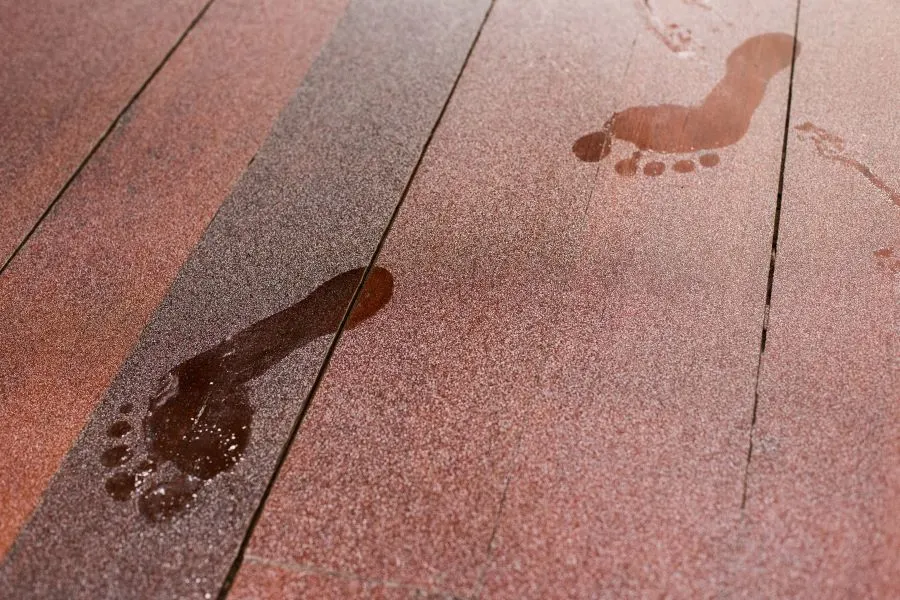We all know how annoying a squeaky floor can be. I bet you cringe when you think about the work and effort that needs to go into finding the source of the squeak and its solution. Luckily, there may be simple ways of reducing this noise with solutions that may be found in your very own bathroom or kitchen cupboard.
Let’s investigate the effectiveness of using talcum powder as a solution and when you should and shouldn’t use talcum powder to stop squeaky floors.

Talcum powder can stop or at least quieten minor squeaks. It is a temporary fix as opposed to a solution. It is only appropriate for use on top floorboards as application requires physical access to the squeaky boards. It is a good, non-invasive first or temporary attempt at stopping squeaks.
The Logic Behind the Hack
Talcum powder is a mixture of talc (a clay material) in its powder form and corn starch. Talcum powder is said to be quite useful when it comes to soothing the annoying sounds produced from squeaking floorboards.
Squeaks can be due to the contracting and expanding wooden panels that are rubbing against one another, movement of loose panels, or it may even be due to a termite infestation. When talcum powder is sprinkled at the source of the squeak, the properties of the powder reduce or can even eliminate the friction between these objects, thus reducing the squeaking noise.
This hack doesn’t require much preparation or special tools. Because the powder is so fine you wouldn’t need to remove any floorboards.
Talcum powder is usually a product that you will probably have lying around your house. If you do not, you can easily purchase it online (amazon link) or from any pharmacy or general store.
If you cannot find talcum powder you can still use similar substances that have a similar effect like flour or corn-starch.
Successfulness of the Talcum Powder Method
Some individuals think it is the most effective method of eliminating squeaking. Talcum powder is, however, more of a temporary fix for those noisy floors. Once applied, you would need to consistently reapply more powder to the problem areas as it will wear off the more you walk over those areas.
The reapplication can become a nuisance and become a messy task for such a short-term solution. It also isn’t guaranteed to eliminate the noise, it is more likely to soften the squeak. Furthermore, all that talcum powder has to go somewhere, and you may find it piled up in your crawl spaces or contributing to the dustiness of your basement.

This method is also more successful for minor problematic areas. It is not effective for more severe cases like floorboards that move because of improper floorboard installation or gaps between the sub-floor and joists. No amount of talcum powder, corn-starch, and flour will solve that problem.
When Will Talcum Powder Definitely Not Work?
Usually, the squeaks between adjacent wooden floorboards would be diminished using talcum powder, however, there are more severe cases where you cannot use it. Smaller, fine hairline gaps that are on the surface are fine for this method but larger gaps are not ideally suited to this hack.
You would also need to be able to physically reach these small gaps with the powder, but it is very difficult or even impossible to do if the problem area is under the top floorboard or carpeting in the subflooring. So, if the squeaking is coming from underneath, you would need to be under the floorboard and sometimes you may not always have easy access to it.
Gaps between the subflooring and the joist allow for the movement against the smooth nail shaft and can be fixed either by applying shims (a thin piece of wedged material) within the gap or by adding a few more screws into the floorboard. Screws usually have spiral grooves down their shaft, which helps with tightening the floorboards and fastening it better to the joist where the boards won’t move. This makes them superior to nails.
When Should I Use This Method?
Because talcum powder is a less invasive method, it is ideal for rentals. If you are renting a space and want to take matters into your own hands, you are limited as to what changes or repairs you are legally allowed to make. It is risky to make major repairs to rental spaces, so temporarily reducing the noise whilst your landlord permanently fixes it may be a reasonable option, especially if your neighbors are complaining.
If the space is not a rental, using powder as the first attempt at the problem is a good way to go before ripping out your entire floor and it turns out to be a minor issue. This is important to remember if you are working in an old home.

It is very difficult to replace the original wooden floorboards of older homes, which add historical value to the home, so it is best to make sure that removing boards is the last resort.
Sources
https://www.youtube.com/watch?v=v3S4WyWA2Zg
https://www.youtube.com/watch?v=529KAs_BCl4
https://www.youtube.com/watch?v=9uZIjRjxbDU
https://www.cancer.org/cancer/cancer-causes/talcum-powder-and-cancer.html
https://www.squeakknights.com/post/popular-diy-squeaky-floor-fixes-you-should-avoid
